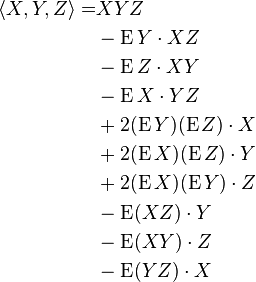Wick product
In probability theory, the Wick product is a particular way of defining an adjusted product of a set of random variables. In the lowest order product the adjustment corresponds to subtracting off the mean value, to leave a result whose mean is zero. For the higher order products the adjustment involves subtracting off lower order (ordinary) products of the random variables, in a symmetric way, again leaving a result whose mean is zero. The Wick product is a polynomial function of the random variables, their expected values, and expected values of their products.
The definition of the Wick product immediately leads to the Wick power of a single random variable and this allows analogues of other functions of random variables to be defined on the basis of replacing the ordinary powers in a power-series expansions by the Wick powers.
The Wick product is named after physicist Gian-Carlo Wick, cf. Wick's theorem.
Definition
The Wick product,
is a sort of product of the random variables, X1, ..., Xk, defined recursively as follows:
(i.e. the empty product—the product of no random variables at all—is 1). Thereafter finite moments must be assumed. Next, for k≥1,
where  means Xi is absent, and the constraint that
means Xi is absent, and the constraint that
Examples
It follows that
Another notational convention
In the notation conventional among physicists, the Wick product is often denoted thus:
and the angle-bracket notation
is used to denote the expected value of the random variable X.
Wick powers
The nth Wick power of a random variable X is the Wick product
with n factors.
The sequence of polynomials Pn such that
form an Appell sequence, i.e. they satisfy the identity
for n = 0, 1, 2, ... and P0(x) is a nonzero constant.
For example, it can be shown that if X is uniformly distributed on the interval [0, 1], then
where Bn is the nth-degree Bernoulli polynomial. Similarly, if X is normally distributed with variance 1, then
where Hn is the nth Hermite polynomial.
Binomial theorem
Wick exponential
References
- Wick Product Springer Encyclopedia of Mathematics
- Florin Avram and Murad Taqqu, (1987) "Noncentral Limit Theorems and Appell Polynomials", Annals of Probability, volume 15, number 2, pages 767—775, 1987.
- Hida, T. and Ikeda, N. (1967) "Analysis on Hilbert space with reproducing kernel arising from multiple Wiener integral". Proc. Fifth Berkeley Sympos. Math. Statist. and Probability (Berkeley, Calif., 1965/66). Vol. II: Contributions to Probability Theory, Part 1 pp. 117–143 Univ. California Press
- Wick, G. C. (1950) "The evaluation of the collision matrix". Physical Rev. 80 (2), 268–272.
- Hu, Yao-zhong; Yan, Jia-an (2009) "Wick calculus for nonlinear Gaussian functionals", Acta Mathematicae Applicatae Sinica (English Series), 25 (3), 399–414 doi:10.1007/s10255-008-8808-0















